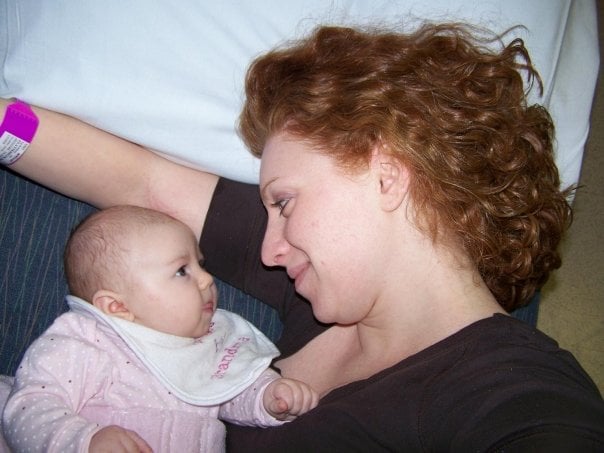Emma Rose arrived August 26, 2008, very much aware of her surroundings and curious about the new world she had just entered. She suffered her first seizure 30 minutes after birth and so began a life-changing journey I couldn’t have imagined and the transformation of who I was into who I would become: Emma’s advocate, fierce and determined. Much of her first year of life was spent in the hospital as her partial focal seizures turned into infantile spasms and there were no answers to be found as to what was going on and why.
We were told again and again by many doctors that there wasn’t anything else to be done and I just needed to accept that. The first 6 months, we went through 5 doctors and 3 hospitals in 3 different states as that just wasn’t good enough for me.
Finally, the seizures became better controlled and I could turn my attention and energy to the cause of them. We were introduced to the world of genetics when Emma was 9 months old, but none of the genetic testing produced an answer as to why my little girl was sick.
 It was also becoming apparent that she had global developmental delays. Emma had multiple spinal taps, EEG’s, bloodwork, CT scans, MRI’s, and skin biopsies during that time. By the time she was 3, we believed she had something degenerative as she ceased drinking, had turned a scary yellow color, and was frequently hospitalized. She was diagnosed with acquired microcephaly, her growth hormone levels were very low, and she had not gained weight in over a year.
It was also becoming apparent that she had global developmental delays. Emma had multiple spinal taps, EEG’s, bloodwork, CT scans, MRI’s, and skin biopsies during that time. By the time she was 3, we believed she had something degenerative as she ceased drinking, had turned a scary yellow color, and was frequently hospitalized. She was diagnosed with acquired microcephaly, her growth hormone levels were very low, and she had not gained weight in over a year.
I actually began planning her funeral: what she would wear, what song best described the joy she brought us, and how to help her two older brothers through something even I could not understand. A plan was made to place a g-tube and in the pre-op testing, it was discovered that she had a malrotated bowel that had somehow been missed and her surgery was made a priority. While placing the g-tube, the malrotated bowel was fixed, and a muscle biopsy performed. The g-tube was at this point considered a life-saving measure, never thought of as something that would have much of a positive impact. But it did. Emma doubled her weight in the 6 months following the surgery, her color became healthy and normal, and her hair was so soft. The muscle biopsy showed a secondary mitochondrial deficiency, but still left us without an answer as to what was really going on. As Emma’s health began to improve following her surgery, it left her doctors more confused and me even more determined.
Over the next three years, Emma was accepted into NIH’s Undiagnosed Disease Program and we continued genetic testing to no avail. People were placed in our life along the way who helped and encouraged me or else I’m not sure I could have pulled myself from the pits of despair at times. It is such a discouraging, lonely journey.
My sole companion was my mother’s instinct and intuition. This crucial part of me along with one of those special people, directed me to enter Emma’s DNA into a study with TGen laboratories in January 2013. My thought at the time was, “why not? It will be, by far, the easiest attempt I have made up to this point to get answers”. December 18th, 2013, a doctor with TGen called to share with me the preliminary results of Emma’s exome sequencing and give me the name of the monster we had been fighting for almost 5 1/2 years.
I will never forget his words. “Your daughter has a rare, de novo STXBP1 gene mutation. Her specific variant has not been reported yet. We don’t know much about it, but can give you information on support groups as well as current studies.” At the time, just having the name, having someone validate what I had been searching for all along, was amazing. I felt almost as if there has been a part of Emma that was in a shadow, a part I couldn’t quite see and they had shown a light on it.
It gave me the peace of mind that it wasn’t something my other 2 children would have to worry about, ever. It gave us a family of fellow STXers that would fight along side of us for treatments, knowledge, and hopefully, a cure. Our life is still filled with ups and downs and unknowns, but it is so much more bearable with our support system.
We are now on a journey to raise awareness and passion in medical professionals for STXBP1. There are currently no known treatments or even explanations as to why some children are able to walk and learn words and others are wheelchair-bound with no form of communication. Some of the children have never had a seizure and others develop Ohtahara syndrome. Our children are literally the pioneers of STXBP1 research. My advice for other parents, first and foremost is always to trust your instinct when it comes to your children. No one knows them better. Also, often answers will not be found in a medical book, neatly printed in the pages. You must be willing to continue digging and never, never, never give up hope!

Stay Connected
Sign up for updates straight to your inbox.
